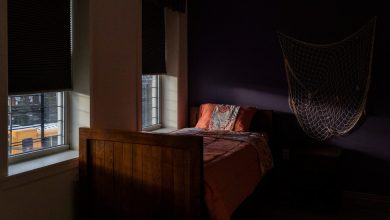Scenes From a City That Only Hands Out Tickets for Using Fentanyl

For the past two and a half years, Oregon has been trying an unusual experiment to stem soaring rates of addiction and overdose deaths. People caught with small amounts of illicit drugs for “personal use,” including fentanyl and methamphetamine, are fined just $100 — a sanction that can be waived if they participate in a drug screening and health assessment. The aim is to reserve prosecutions for large-scale dealers and address addiction primarily as a public health emergency.
When the proposal, known as Measure 110, was approved by nearly 60 percent of Oregon voters in November 2020, the pandemic had already emptied downtown Portland of workers and tourists. But its street population was growing, especially after the anti-police protests that had spread around the country that summer. Within months of the measure taking effect in February 2021, open-air drug use, long in the shadows, burst into full view, with people sitting in circles in parks or leaning against street signs, smoking fentanyl crushed on tinfoil.
Since then, Oregon’s overdose rates have only grown. Now, tents of unhoused people line many sidewalks in Portland. Monthslong waiting lists for treatment continue to lengthen. Some politicians and community groups are calling for Measure 110 to be replaced with tough fentanyl possession laws. Others are pleading to give it more time and resources.




Washington Center, a vacant building that was used as an open-air drug market, being boarded up; Kristiana Bolin and her husband, Josh, moved to Portland a year ago, live out of a van and use fentanyl; boarding up the building; a police cruiser at the site.
The following is a mosaic of voices and images from Portland today.
Working downtown
On her walk to work at Forte Portland, a coffee shop and wine bar that she operates with her brother in the sunken lobby of a commercial building, Jennifer Myrle sidesteps needles, shattered glass and human feces. Often, she says, someone is passed out in front of the lobby’s door, blocking her entrance. The other day, a man lurched in, lay down on a Forte couch, stripped off his shirt and shoes, and refused to leave.
“At four in the afternoon the streets can feel like dealer central,” Ms. Myrle said. “At least 20 to 30 people in ski masks, hoodies and backpacks, usually on bikes and scooters. There’s no point calling the cops.”

Jennifer Myrle manages a wine and coffee bar downtown. “At four in the afternoon the streets can feel like dealer central,” she said. “There’s no point calling the cops.”
Despite the street turmoil, Ms. Myrle likes to go for strolls on her breaks. “But at 11:30 on a Tuesday morning, I walked to the block between Target and Nordstrom and in the middle of everything,” she said, she saw a woman performing an act of oral sex on a man.
She is keenly aware that she’s witnessing a confluence of longstanding societal problems, including mental health and housing crises. “But it’s so much the drugs,” she said.
Patrolling with a gun and Narcan
Officer David Baer of the Portland Police Bureau patrols downtown on a mountain bike, armed with a gun, a citation pad and the overdose-reversal drug Narcan. He spends his shift arresting street dealers carrying large quantities of blue fentanyl pills, writing $100 citation tickets for people injecting or smoking drugs in public and administering Narcan to those nodding out, an emergency he encounters at least once a day.
Such scenes are portrayed on the Portland Police Central Bike Squad’s Instagram account, which has generated intense reaction.
“I get a lot of feedback in the DMs: ‘You need to let the addicts die, they shouldn’t be Narcanned,’” Officer Baer said, adding: “That’s tough to read because we interact with these people every day. I’ve worked on the same person multiple times.”
One person Officer Baer has helped for years is a man named Justin. During night patrol shifts in North Portland, he would encounter Justin drunk from a night at the bars and drive him home.
“The other day I was biking around and I look over — ‘Why is that guy bleeding over there?’ I roll him over and it’s Justin!” Office Baer said.
“He had come downtown, and now he’s addicted to fentanyl. So I Narcanned him and he came back. Twice, now, I think.”
A big part of his job is writing Measure 110 tickets. “It’s like, ‘Hey, you can’t smoke meth or fentanyl on the sidewalk or on the playground.’ And the pushback we get? People can be really aggressive. They think they’re in the right because they think drugs are legal.
“I say, ‘Beer is legal, but you still can’t drink beer in public.’ So we cite them and give them the drug screening card. Then they’ll say they don’t want treatment or they’ll tell us, ‘OK, I’ll call the number.’
“And two hours later we run into them again, and they’re smoking or even overdosing.”
Living on a sidewalk
“Portland is a homeless drug addict’s slice of paradise,” said Noah Nethers, who was living with his girlfriend in a bright orange tent on the sidewalk against a fence of a church, where they shoot and smoke both fentanyl and meth.
He ticked off the advantages: He can do drugs wherever he wants and the cops no longer harass him. There are more dealers, scouting for fresh customers moving to paradise. That means drugs are plentiful and cheap.
Downsides: Tent living is no paradise, he said, especially when folks in nearby tents, high on meth, hit him with baseball bats.
Plus, eviction notices for the tents had just been posted ordering everyone to be gone the next day by 8 a.m. He didn’t know where he would move next. But if he didn’t clear out, he said, the police would gather his stuff, store it for a month and then toss it.
Measure 110 also did not dial back the hatred and derision he gets from homeowners — people with jobs, full refrigerators, paid vacations. He feels those glares keenly, not least because for a time, his life resembled theirs.




Noah Nethers hoped to write books; fentanyl hidden in a sock; a blue fentanyl pill, partially smoked on tinfoil; Mr. Nethers cleaning a fentanyl pipe in his tent.
Growing up in Detroit, he dreamed of becoming an English teacher and writing books. But in fifth grade, he started poking around his older brother’s sock drawer and found his weed stash. By high school, Mr. Nethers was smoking crushed-up OxyContin pills. Then he tried heroin.
He was in and out of rehab, five or six times. And prison.
During the years he was able to claw his way to sobriety, Mr. Nethers worked in construction, made rent and became a father.
He moved to Denver, but heroin found him again. For a long time he could shoot up and keep working. But after two big overdoses, he said, “My conscience was tearing me up, and I had to get out.”
Four years ago, he moved to Portland, where a sister lives. But drugs pulled on him. Then the pandemic hit. Finally, the streets summoned. “I was hanging on as long as humanly possible, trying to find the heroin dealers, but then they were gone,” Mr. Nethers, now 42, said. “So I got on the fentanyl roller coaster.”
Lately, he has been trying to take a hard look at his daily struggles.
“I want to pull up the plane before it totally hits the side of the mountain,” Mr. Nethers said. “I mean, please, please God, tell me there’s a way to make it out of this.”
Getting so many calls for help
Solara Salazar, a director of Cielo Treatment Center, which serves young adults in Portland, now receives about 20 inquiries a day about rehab services. “And the majority of them we can’t help,” she said.
Cielo offers outpatient therapy and sober housing. That is great for people who have already begun managing their addictions, but Ms. Salazar, who survived addictions to meth, OxyContin and fentanyl, keeps hearing from those in acute crisis who need a bed in a residential program right away.
She gets pleas from people leaving hospital detox, who have not yet gone through inpatient rehab. Oregon’s Medicaid patients can wait months for a treatment bed, she and others said.
“You just can’t skip a step and expect people to be successful,” she said. “We have a really low success rate that way.”




Solara Salazar of Cielo Treatment Center, led a rehab graduation ceremony; Gabriel Robles-Ellis, who had used fentanyl, spoke at the ceremony; while meeting with candidates for county commissioner, neighbors spoke about Measure 110’s impact.
Funding for Measure 110’s promise of increased services comes from Oregon’s marijuana tax revenues. After a slow start, more than $265 million has flowed to programs that try to make drug use safer by providing clean needles and test strips, offer culturally specific peer support and provide shelter for people newly in recovery. But residential treatment for addiction has yet to be substantially expanded.
Yet critics of 110 say that few drug users who received $100 fines sought rehab.
Ms. Salazar rejects that claim. “The story out there is, ‘Measure 110 doesn’t work because people don’t want treatment.’ That is simply not true,” she said.
“I’m a strong advocate for harm reduction,” she continued. “The model used to be ‘all treatment, no harm reduction’. But now there’s a push to ‘all harm reduction, no additional residential treatment’— with no happy medium,” said Ms. Salazar, who is on the board of Oregon Recovers, which lobbies for improved treatment and support.
“I talked to a woman the other day who’s living in her car, and she was sobbing and crying and so desperate for treatment. I’m trying to give her some hope and I say, ‘Just keep trying and you’re going to make it,’ but I know that’s a lie. She’s not pregnant, so she doesn’t meet the benchmark for an immediate bed. And I’m going to tell her she has to call every single day for four months and then maybe she’ll get a bed?”
Unifying divided neighbors
For months, a beat-up van with a duct-taped storage box on the roof has been parked across the street from SS. Peter and Paul Episcopal Church in southeastern Portland, doing a brisk business at all hours. The Rev. Sara Fischer thinks the owners are dealing drugs; she recognizes some customers, who also show up in the parking lot of her church, which hosts a county needle exchange program.
Many people in the church’s congregation have expressed frustration with the pervasive, public drug use in the neighborhood, a diverse, scrappy and gentrifying area called Montavilla. But suggestions for how to respond are divisive.
Some want the drug users evicted: They are angry that their kids must dodge tents on their way to school, and witness overdoses, frenzied fits and public defecation. But others, she said, worry about how to get the tent dwellers better and more constant care.
On Sundays, the church sponsors a potluck dinner for everyone in the community, whether they live in tents or comfortable homes. Here, the better-off do not serve food to those without. Instead, all diners eat together. They share life stories, play music and make art.
“Once we know people’s names and stories, they’re not so scary,” Ms. Fischer said. “They cease to be the ‘they’ out there.”
She can’t predict the fate of Measure 110 but firmly believes that criminalizing addiction to drugs is the wrong response to complex problems.
“I think Measure 110 needs more time,” she said.




